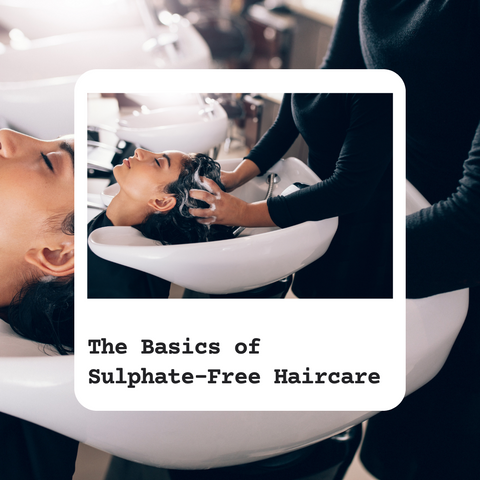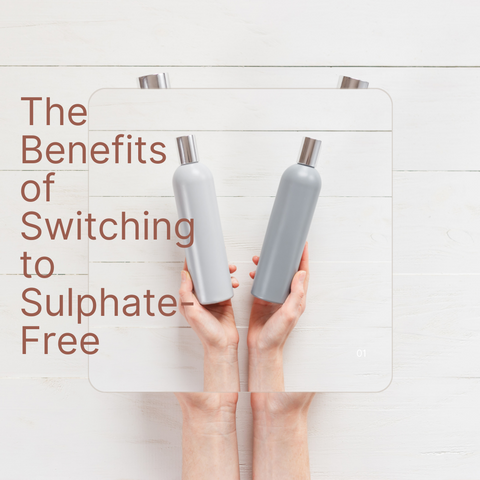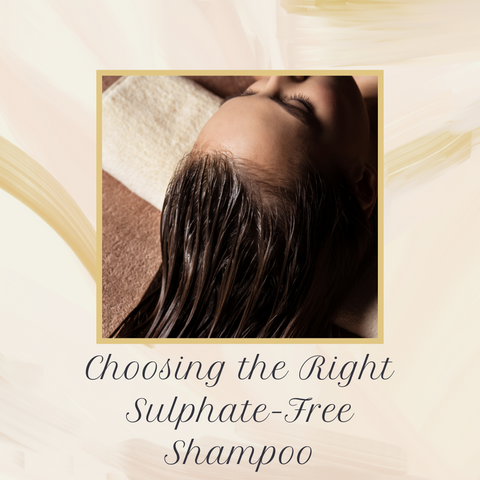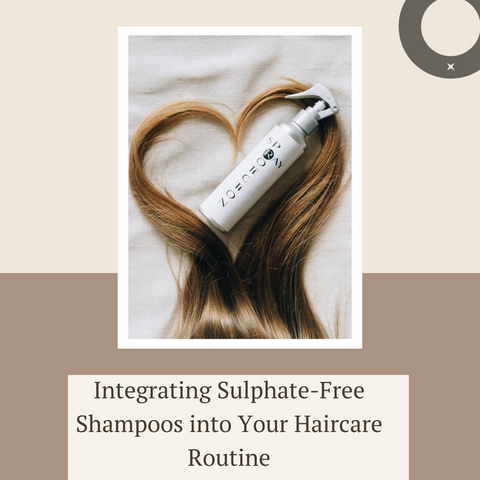The popularity of sulfate-free shampoos is due to their milder and gentler composition, which can assist a variety of hair types, particularly those prone to dryness, sensitivity, or color-treated hair. Sulphates, which include sodium lauryl sulphate (SLS) and sodium laureth sulphate (SLES), are common surfactants in many traditional shampoos. While excellent at cleansing, sulphates can take natural oils from the hair, causing dryness, irritation, and colour fading in treated hair. This blog will explain why sulfate-free shampoos have become popular.
The Basics of Sulphate-Free Haircare

Sulfate-free haircare entails using shampoos, conditioners, and styling products free of sulphates, specifically sodium lauryl sulphate (SLS) or sodium laureth sulphate (SLES). Many conventional hair solutions contain surfactants that are responsible for producing lather and efficiently washing the hair and scalp. The fundamentals of sulfate-free haircare include gentle washing, reduced scalp irritation, color preservation, moisturising and nourishing, suitability for certain hair types, and environmental friendliness. When selecting haircare products, however, it is critical to consider individual needs and preferences. If in doubt, a hairstylist or dermatologist can advise you on the best sulfate-free products for your hair type and scalp health.
What Makes Sulphate-Free Shampoos Different
Sulfate-free shampoos differ from typical shampoos chiefly in their formulation, notably the absence of certain washing chemicals known as sulphates. Surfactants, milder washing agents, less irritation, color preservation, moisturising components, suitability for certain hair types, lather and cleansing differences, and environmental friendliness are the primary factors that set sulfate-free shampoos apart. Transitioning to sulfate-free products may require an adjustment time for the hair and scalp to acclimatise to milder cleansing agents, but they can provide benefits for a variety of hair types and scalp issues.
Key Ingredients in Sulphate-Free Formulas
Sulfate-free shampoos use alternative cleansing agents and ingredients that are gentler on the hair and scalp than sulphates like sodium lauryl sulphate (SLS) or sodium laureth sulphate (SLES). The following are some key ingredients that are commonly found in sulfate-free formulas:
-
Cocamidopropyl Betaine: This is a mild surfactant derived from coconut oil. It effectively cleanses the hair without stripping away natural oils, making it suitable for those with sensitive skin or a dry scalp.
-
Decyl Glucoside: A gentle surfactant derived from corn starch and coconut. It cleanses the hair while being gentle and less likely to cause irritation.
-
Disodium Laureth Sulfosuccinate: This mild cleansing agent is commonly used in sulfate-free shampoos because it cleans without causing excessive dryness or irritation.
-
Cocamide MEA (Monoethanolamide): This ingredient gives sulfate-free shampoos a creamy texture and aids in cleansing without stripping the hair of natural oils.
-
Natural Extracts and Oils: Many sulfate-free shampoos contain botanical extracts, essential oils, or plant-based ingredients such as aloe vera, argan oil, coconut oil, jojoba oil, shea butter, or avocado oil. These ingredients hydrate, nourishes, and moisturise the hair and scalp.
-
Glycerin: It's a humectant that helps retain moisture in the hair, preventing it from becoming dry or brittle.
-
Formulations Without Silicones: A few shampoos that are free of sulphates are also made without silicones. While silicones can give hair a smooth and glossy appearance, they can also cause buildup and weigh down hair in some people. Silicone-free formulations keep this buildup at bay.
-
Natural Preservatives and Fragrances: To avoid harsh synthetic additives, sulfate-free shampoos frequently use natural preservatives such as essential oils or plant extracts, as well as natural fragrances.
These ingredients work together to cleanse the hair and scalp while keeping moisture in place and reducing irritation. Sulfate-free shampoos are designed to be gentler alternatives to sulfate-containing shampoos, making them ideal for people with sensitive skin, dry hair, or those looking for more natural and less harsh cleansing options.
Understanding the Impact of Sulphates on Hair and Scalp
Because of their capacity to build lather and efficiently remove debris, oil, and pollutants from the hair and scalp, sulphates such as sodium lauryl sulphate (SLS) and sodium laureth sulphate (SLES) are extensively used surfactants in many shampoos and haircare products. However, these sulphates may have the following effects on the hair and scalp:
-
Stripping Natural Oils: Sulphates are efficient cleaners that remove dirt and grease from the hair. They can, however, be overly effective, removing not just excess oils but also natural oils that keep the scalp and hair nourished. This might cause dryness and irritation, especially in people who have sensitive or dry scalps.
-
Scalp Irritation: Sulphates can induce scalp irritation and inflammation, resulting in discomfort, itching, and even disorders such as dermatitis or eczema, especially in people with sensitive skin.
-
Dryness and Frizziness: Excessive sulphate use can cause dry, frizzy, and brittle hair. The loss of natural oils can roughen and damage the hair shaft, resulting in a lack of moisture and increased frizz.
-
Color Fading: Sulphates can hasten the fading of colour in coloured or treated hair. They remove the natural oils and pigments in the hair, causing the colour to fade faster than desired.
-
Weakening of Hair: Harsh sulphates can weaken hair strands over time, making them more susceptible to breakage, split ends, and general hair damage.
-
Sensitive Scalp Reactions: Some people may have allergic reactions or increased sensitivity to sulphates, resulting in increased irritation, redness, or itchy on the scalp.
-
Exacerbating Scalp Conditions: Sulphates can aggravate pre-existing scalp disorders such as psoriasis or seborrheic dermatitis by causing greater dryness, flakiness, or irritation.
The Benefits of Switching to Sulphate-Free

Switching to sulfate-free haircare products can provide various advantages, particularly for people who have specific scalp sensitivities, dryness, or hair texture or colour difficulties. Reduced scalp irritation, gentle cleansing, hydrated and moisturised hair, colour preservation, healthier hair, appropriate for curly or coarse hair, ecologically responsible alternatives, and improved scalp and hair condition are some of the benefits of switching to sulfate-free formulations. While sulfate-free shampoos provide numerous benefits, their performance may vary depending on individual hair types, preferences, and specific haircare needs. Experimenting with several sulfate-free products can assist in determining the best alternative for maintaining healthy hair and scalp while avoiding the potential downsides linked with sulphates.
Nurturing a Healthier Scalp
Maintaining a healthy scalp is essential for overall hair health and appearance. Here are some suggestions for nurturing and promoting a healthier scalp:
-
Regular Cleaning: Use a gentle, sulfate-free shampoo that is appropriate for your hair type to wash your hair on a regular basis. Cleanse your scalp thoroughly to remove dirt, oil, and product buildup. The frequency with which you wash your hair will be determined by the type of hair you have and the condition of your scalp.
-
Balanced Diet: To support overall scalp health and hair growth, eat a well-balanced diet rich in vitamins, minerals, and nutrients. Make sure you get enough protein, omega-3 fatty acids, vitamins A, C, and E, as well as zinc.
-
Scalp Massages: Massage your scalp gently while shampooing or with scalp oil to stimulate blood circulation and promote a healthier scalp. This can also help to relieve stress and tension in the scalp.
-
Hydration: Drink plenty of water every day to stay hydrated. Sustaining the moisture balance of the scalp requires adequate hydration.
-
Minimise Heat Styling: To prevent damage to the scalp and hair follicles, use less heat-styling equipment. If using heat to style is required, use products that protect against heat.
-
Avoid UV Exposure: When spending a lot of time outside, shield your scalp from the sun's damaging UV rays by donning a hat or using SPF-containing hair care products.
-
Avoid Harsh Products: Avoid using harsh haircare products and styling treatments that can irritate the scalp or strip away natural oils. Choose products that are gentle, sulfate-free, and pH-balanced.
-
Avoid Overwashing: While it is important to keep your scalp clean, overwashing can strip away natural oils and cause dryness. Determine a washing schedule that is appropriate for your hair type and scalp condition.
-
Manage Stress: Stress can cause scalp problems such as dandruff or increased oil production. To promote scalp health, use stress-reduction techniques such as meditation, yoga, or mindfulness.
-
Frequent Hair Trims: Always trim your hair to get rid of split ends and stop them from growing up the hair shaft, which could harm the health of your scalp.
-
See an Expert: See a dermatologist or trichologist for guidance if you are experiencing ongoing problems or concerns with your scalp. They can make personalised recommendations and treatments for specific scalp conditions.
Preserving Natural Hair Oils
Preserving your hair's natural oils is critical for maintaining scalp health, promoting hair growth, and preventing dryness and brittleness. Here are some suggestions for preserving natural hair oils:
-
Use Gentle Cleansers: Select sulfate-free and mild shampoos that effectively cleanse the scalp without stripping away excessive natural oils. Over-washing or using harsh cleansers can upset the scalp's oil balance.
-
Condition on a regular basis: Use a conditioner or hair mask to nourish and hydrate the hair without weighing it down. Apply conditioner to the ends and lengths of the hair rather than the scalp.
-
Avoid Using Hot Water: Using hot water to wash your hair can strip away natural oils. Instead, use lukewarm or cool water to keep the hair cuticles closed and retain moisture.
-
Limit Washing Frequency: Avoid washing your hair every day because it can strip essential oils. Wash your hair as needed, depending on your hair type and scalp condition.
-
Scalp Massage: While washing, gently massage the scalp with your fingertips to evenly distribute natural oils and stimulate blood circulation, promoting healthier hair growth.
-
Apply Natural Oils sparingly: Applying natural oils to the ends or lengths of your hair, such as coconut oil, argan oil, or jojoba oil, can help retain moisture. Excessive oil use, on the other hand, can weigh down the hair and attract dirt, so use it carefully.
-
Protective Hairstyles: Consider wearing protective hairstyles like braids or buns to help preserve natural oils by limiting your exposure to elements that can drain moisture from your hair, such as wind or sun.
-
Avoid Over-styling: Heat styling equipment and chemical treatments that might dry out the hair and scalp should be avoided. When styling with heat, use heat protectants.
-
Dry Hair Gently: Avoid rough towel-drying or aggressive rubbing, which can disrupt the cuticle of the hair and cause frizz and breakage. Instead, gently pat or squeeze the excess water out of your hair.
-
Balanced Diet: To support overall scalp health and maintain natural oil production, consume a balanced diet rich in omega-3 fatty acids, vitamins, and minerals.
-
Regular Trims: Trim the ends of your hair on a regular basis to prevent split ends, which can contribute to moisture loss and make the hair more prone to breakage.
By following these tips, you can help maintain a healthy balance of natural oils in your hair and scalp, promoting healthier, more vibrant hair that is free of excess dryness or oiliness. For the best results, modify these suggestions based on your hair type, texture, and specific scalp needs.
Enhancing Hair Color and Texture
Treatments, products, and style techniques can all be used to improve the colour and structure of your hair. Here are some pointers to help you improve the colour and texture of your hair:
-
Hair Coloring: To attain the appropriate hue and tone while minimising damage, consult a hairstylist for professional hair colouring treatments. Adding highlights or lowlights can add texture and depth to your hair colour, making it look more vibrant. These treatments can add gloss, vitality, and texture to hair without causing damage.
-
Hair Care Products: To preserve vibrancy and avoid colour fading, use products designed specifically for color-treated hair. To improve hair texture, restore moisture, and add shine, use deep-conditioning masks or treatments.
-
Heat Styling: To enhance texture and style, use styling tools to produce defined curls or sleek straight hair. To avoid damage, apply heat protectant products before style. Blow-drying your hair can increase volume and texture. For smoother results, use a round brush.
-
Natural Remedies and Treatments: As a deep conditioning treatment, apply natural oils to your hair to improve texture, add shine, and minimise frizz. Apple cider vinegar, when diluted, helps clarify the hair, reduces buildup, and improves lustre.
-
Scalp Care: Use moderate, sulfate-free shampoos and moisturise the scalp to keep it healthy. A healthy scalp encourages better hair growth and texture.
-
Protective Styling: By avoiding exposure to environmental stresses, protective hairstyles can help maintain hair health and texture.
-
Regular Trims: Trimming your hair on a regular basis can help you avoid split ends, which can make your hair look drab and unhealthy. Trimming aids in the maintenance of hair health and texture.
-
Diet and Hydration: Consume meals high in key vitamins and minerals for hair health, such as omega-3 fatty acids, biotin, and vitamins A, C, and E. Keep your hair hydrated and healthy from the inside out by drinking enough of water.
Individual hair types and demands differ, so it's critical to select procedures and products that are appropriate for your hair texture, condition, and intended outcome. A consultation with a hairstylist or dermatologist can provide personalised recommendations for improving the color and texture of your hair while maintaining its health.
Choosing the Right Sulphate-Free Shampoo

The best sulfate-free shampoo for you is determined by a variety of factors, including your hair type, scalp condition, specific issues, and personal preferences. Here's how to choose the best sulfate-free shampoo for you:
-
Hair Type: Look for sulfate-free shampoos that are hydrating and moisturising. Ingredients such as argan oil, shea butter, and coconut oil can nourish and moisturise dry hair. Choose sulfate-free shampoos that clean gently without depleting natural oils. Tea tree oil and aloe vera are two ingredients that can help balance oil production without drying out the scalp.
-
Scalp Condition: To soothe inflammation and maintain scalp health, look for sulfate-free shampoos that have soothing ingredients like aloe vera, chamomile, or oat extract. To treat dandruff while being gentle on the scalp, look for sulfate-free shampoos containing tea tree oil, salicylic acid, or pyrithione zinc.
-
Color-Treated Hair: Choose sulfate-free shampoos formulated specifically for color protection for colored hair. These shampoos aid in the preservation of hair color and the prevention of fading. Look for terms such as "color-safe" or "color-protecting" on the label.
-
Ingredients to Consider: Natural and nutritious components such as natural oils (coconut, argan, jojoba), plant extracts, vitamins (such vitamin E), and antioxidants can be found in the ingredient list. If you want a cleaner, more natural formulation, avoid harsh chemicals or irritants such as parabens, synthetic scents, and silicones.
-
Specific Concerns: Some sulfate-free shampoos are designed to address specific issues like frizz control, volume augmentation, or strengthening. Choose a shampoo that is tailored to your specific hair needs.
-
Trial and Observation: Before purchasing a full-size sulfate-free shampoo, test out trial packages or smaller bottles. To verify compatibility, observe how your hair and scalp react to the product after a few washes.
-
Consult Professionals: Consult a doctor or hairstylist for recommendations customised to your hair and scalp condition if you have recurring scalp difficulties or concerns about certain ingredients.
Due to various hair traits and preferences, what works well for one person may not work well for another. Finding the appropriate sulfate-free shampoo may require some trial and error, so be patient and open to trying numerous alternatives until you discover one that meets your needs and produces the desired effects for your hair and scalp.
Sulphate-Free Options for Different Hair Types
Here are some sulfate-free shampoo options for various hair types:
-
For Dry or Damaged Hair: Shea butter and argan oil deeply moisturise and repair damaged hair. Avocado oil and quinoa extract are used to hydrate and strengthen dry, damaged hair.
-
For Oily Hair: lemon essential oil and jojoba oil to control excess oil without stripping the scalp. Aloe vera and lemon essential oil help to balance and gently cleanse oily hair.
-
For Sensitive Scalp: An all-natural, mild formula that works well for scalps that are easily irritated or allergic. Hypoallergenic and devoid of harsh chemicals, making it appropriate for delicate scalps.
-
For Color-Treated Hair: A sulfate-free formula with green tea and jojoba extracts that works to moisturise and protect color-treated hair.
-
For Curly or Coarse Hair: Curls are moisturised and defined with shea butter and natural oils. A non-lathering, conditioning cleanser for curly hair that keeps natural oils intact
-
For Fine or Thin Hair: A lightweight formula that adds body and volume without weighing down fine hair. Infused with natural ingredients like rahua oil, it adds volume and bounce to fine or thin hair.
individual hair types may respond differently to products, so it's essential to consider your specific needs and preferences when selecting a sulfate-free shampoo. Conduct a patch test or try sample sizes before committing to a full bottle to ensure compatibility with your hair and scalp.
Reading Labels: Identifying Sulphate-Free Products
Sulfate-free items must be identified by carefully examining product labels. Look for specific ingredients, common sulphate ingredients to avoid, "sulfate-free" claims, read the full ingredient list, check for other harsh ingredients, certification seals or symbols, online resources, and trial or sample sizes to help you identify sulfate-free shampoos or haircare products. This variance in lather has no bearing on the product's ability to cleanse your hair. You can find sulfate-free options that meet your haircare needs by reading labels and understanding ingredients.
Top Sulphate-Free Shampoos Available in India
Some popular sulfate-free shampoos available in India are
-
Sebamed Hair Care Everyday Shampoo: Enjoy gentle hair care daily with the Sebamed Hair Care Everyday Shampoo, formulated with active cleansing agents of plant-based origin. As it is created with the same pH value of 5.5 as healthy skin, it supports and protects the acidic mantle of the scalp for healthy hair, while protecting the hair and scalp from drying out, and at the same time. It is also useful for adding volume to the hair and enhance its shine.
-
Bioderma Node G Purifying Shampoo: Gently and effectively cleanse your hair and scalp with the Bioderma Node G Purifying Shampoo specially formulated for those who wash their hair frequently. It is a mild, sulphate-free shampoo that contains a unique combination of surfactants that is suitable for daily use. Node G Fluide in the shampoo preserves the essential components of the hydro-lipid film wash after wash and therefore is non-delipidating for the scalp. The shampoo is ideal for all age groups and hair types. It can be used by people who have had their hair straightened and is also great to use in conjunction with medicated shampoos. In addition to protecting hair and scalp, this shampoo helps restore hair to its natural shine and luster.
-
Sebamed Revitalizing Shampoo: Get relief from dry scalp and scalp irritation with the active plant complexes in Sebamed Revitalizing Shampoo. This revitalising shampoo has a moisture formula that counteracts scalp dehydration. The shampoo is formulated with an extra mild wash active compound of wheat germ protein combined with soy protein. Thus, it soothes and regenerates the structure of the hair and relieves the dryness of the scalp. Suitable for sensitive and dry scalp.
-
Renocia Hair Revitalizing Shampoo: A clinically proven formula that helps promote longer, thicker, and healthier hair. Renocia Hair Revitalizing Shampoo is designed to stimulate and fortify the hair and scalp, creating a healthy environment for hair restoration.
-
Aclaris Follicapil Shampoo: Revitalise your hair growth with the advanced formulation of Aclaris Follicapil Shampoo that acts directly at the follicle. Shampoo is an effective way to reduce inflammation and increase hair growth. It helps rebalance the hair cycle and prevents excessive hair fall after just six weeks of regular use. It is suitable for use by both men and women.
Consider your hair type, specific problems, and ingredient preferences when choosing a sulfate-free shampoo. If you have sensitivities or allergies, always read the entire ingredient list and perform a patch test. Furthermore, availability and product composition may change over time, so it's best to look for the most recent products on the market.
Integrating Sulphate-Free Shampoos into Your Haircare Routine

Integrating sulfate-free shampoos into your haircare routine entails changing your washing frequency, choosing complimentary products, and learning how these shampoos interact with your hair. Transition period, washing frequency, complimentary products, reduced lather, clarifying shampoo, avoiding heavy styling products, scalp massage, observation, and adjustment, patience, and consistency are some guidelines. Remember that everyone's hair is unique, so what works for one person may not work for another. When incorporating sulfate-free shampoos into your haircare routine, experimentation, observation, and patience are essential.
Tips for Transitioning to Sulphate-Free Haircare
Transitioning to sulfate-free haircare can improve the health of your hair and scalp. Here are some pointers to help you make the transition smoothly:
-
Gradual Transition: Begin by gradually decreasing the frequency with which you use sulfate-based shampoos. During the transition period, alternate between using your regular shampoo and a sulfate-free option to allow your scalp to adjust.
-
Clarifying Wash: Before beginning the transition, consider doing a clarifying wash with a sulfate-based shampoo to remove any buildup or residues from your hair.
-
Patience During Adjustment: Recognise that it may take some time for your hair and scalp to adjust to sulfate-free products. During this transition period, your hair may feel different as it adjusts to milder cleansing agents.
-
Choose the Right Sulfate-Free Products: Choose sulfate-free shampoos and conditioners that are appropriate for your hair type and needs. To keep your hair healthy, look for natural and nourishing ingredients.
-
Scalp Massage: Gently massage your scalp while washing your hair with sulfate-free shampoo to ensure thorough cleansing and blood circulation. To effectively remove dirt and excess oils, concentrate on the roots and scalp.
-
Use Less Product: Sulfate-free shampoos may not lather as well as sulfate-based shampoos. Apply a small amount at first and more as needed, focusing on the scalp rather than the lengths of your hair.
-
Condition Well: After cleansing, hydrate and nourish your hair with a deep conditioning treatment or a sulfate-free conditioner.
-
Steer Clear of Heavy Styling Products: Use fewer or lighter styling products during the transition period to avoid product buildup.
-
Be Aware of Ingredients: Read the labels of all the hair products you use, not just the shampoos and conditioners. Products with sulphates or other harsh chemicals should be avoided.
-
Be Patient and Observant: Your hair and scalp may need a few weeks to completely acclimatise to sulfate-free products. Be patient and watch to see how your hair reacts to the new routine.
Keep in mind that the adjustment period will differ from person to person. Some may notice changes quickly, while others may take longer. Listen to your hair's needs and adjust your routine accordingly for the best results.
Maintaining Hair Health with Regular Use
Maintaining hair health with sulfate-free products requires a consistent haircare practise that is suited to your hair's demands. Appropriate washing frequency, use of the right amount, gentle cleansing techniques, hydrating conditioners and treatments, avoiding heat damage, protecting hair from environmental stressors, regular trims, balanced diet and hydration, avoiding overprocessing, stress management, scalp health, observation, and adaptation are tips for maintaining hair health with regular use of sulfate-free products. Following a mild haircare programme on a regular basis, preserving your hair from damage, and attending to its needs will help keep your hair healthy, lustrous, and strong over time.
















